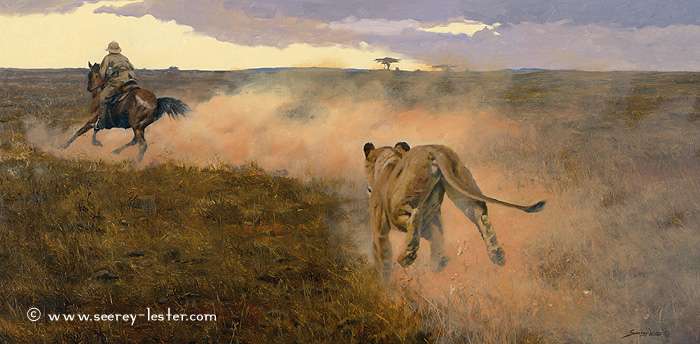
"Hell
for Leather"
Oil on panel, 18x36"
Price on request
The hunter rode as hard as possible,
giving spur and going hell-for leather, but the lioness was catching
up. The hunter had good hands and his mount was well schooled
for galloping lions, probably a polo pony, but it was hard to
compete with the pace of this lioness. As he was twisting and
turning at great speed to outrun and confuse his foe, he was
thinking how foolhardy he had been to get himself into this situation.
Evidently, a situation from which he may not escape.
The lioness was now gaining on him; how
could this be? As she got nearer, he resolved that a charging
lion must be at top speed from the very start. He was getting
all he could from his pony, but it had taken a time for his mount
to get into its stride, and the lioness was almost upon him.
The trail of dust snaked its way across the savannah as the
two zigzagged towards the horizon. Holding the reigns lightly
with his left hand, he reached to un-holster his Colt .45 revolver.
He was riding lions without a rifle, a sport not to be recommended.
The lioness was now along side and level
with his leg; he knew that at any moment it would strike out
at him or the horse. All the time struggling to control his
mount, which was now at full gallop, he tried desperately to
aim the gun at the lioness as she approached on his left flank.
Keeping the pony on a straight course, he leaned across and
fired best he could. Had he hit her? He couldn’t tell,
even at such close quarters. As he re-holstered his gun and
focused on heading for safety, the lioness slowed and went behind
him, but he continued to ride hard. He eventually pulled up
his mount and looked back to see the lioness limping and heading
for the cover of a reed bed.
As he recovered his composure he reflected
on what had happened, and his three glaring mistakes. He had
split from the main hunting party to follow three lions, who
had separated from the main pride when the hunters had approached.
He knew where two of them had gone, but had lost sight of one.
Leaving his gun-bearer behind with his rifle (mistake number
one), he galloped off to find her. Unwisely, he dismounted
and walked away from his mount towards some high ground so he
could view the surrounding area (mistake number two). To his
surprise, the lioness sprang into view from low cover, and stood
staring at him angrily, only a few paces away. His heart nearly
stopped. All he had was his colt .45 which would have been useless
against her. He gradually inched his way backwards, never taking
his eye off the lioness, until he reached his mount. He quickly
turned and sprang into the saddle and rode off to a distance
of some thirty yards. When he looked back he was shocked to
see that the lioness was still in the same place, staring at
him. His fear now turned to anger. Anger at himself for being
so foolish. In his self imposed temper he aimed and fired at
the lioness, (mistake number three), which now came on at speed,
and the chase was on.
He now presumed the lioness had limped
into the reed bed as a result of that first shot. Later having
recovered his rifle, he and the other hunters found the lion
and finished her off.
The hunter was Arthur Blayney Percival,
an experienced hunter who had killed several hundred lions during
his time in British East Africa, later Kenya. After the First
World War, he became Game Ranger for the British Colony and
although he never reached the fame of his older brother Philip
(Pops in Hemingway’s Green Hills of Africa) he was
one of the most respected hunters in Africa at that time.
|